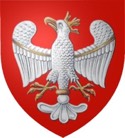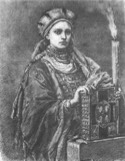Family Card - Person Sheet
Family Card - Person Sheet
Misc. Notes
Mieszko I (ca. 935 - May 25, 992), son of the semi-legendary Siemomysl, was the first historically known Piast duke of the Polans, who gave their name to the country that would later be called "Poland." Mieszko was not the duke's actual name but was given to him later - contemporary documents called him Mesco, Misico, Mesico, Msko or similar, with one strange exception - he also appeared as Dagome in document called Dagome iudex.
In 965 he married Dobrawa (Dobrava, Dubrawka), daughter of Boleslav I, Duke of Bohemia. In 980 he married Oda von Haldensleben, daughter of Dietrich (Theoderic) of Haldensleben, Count of the North March (965-985), after abducting her from the monastery of Kalbe.
The early career of Mieszko was dominated by fighting with the tribes of Wieletes and Volinians south of the Baltic Sea, and their ally, the Saxon count Wichman. Mieszko was baptised in 966, probably under the influence of his Christian first wife or perhaps in order to avoid confrontation with the Holy Roman Empire to the west. He built a church dedicated to Saint George at Gniezno and in 968 he founded the first Polish cathedral in Poznan dedicated to Saint Peter. Those events are also known as the baptism of Poland.
At the time of the reign of Mieszko there was no single place serving as the capital, instead he built several castles around his country. Of the most important were: Poznan, Gniezno and Ostrów Lednicki. The latter was a ring-fort some 460 feet in diameter, containing his residence, a fine stone palace, the country's first monumental architecture.
He had probably one sister of unknown name, and two brothers: one of them, name unknown, was killed in battle around 964; the second, named Czcibor, died in the Battle of Cedynia in 972.
Some historians suggest that Mieszko I had pledged allegiance to emperor Otto I the Great, to emperor Otto II and again to emperor Otto III. However, there is much dispute over this point from the Polish side - mainly whether his allegiance represented the whole of Poland, or only part (the disputed fragment is "usque Varta fluvium"). One medieval chronicle also states that Mieszko pledged allegiance to Margrave Gero, but since the chronicle itself is believed to be an abstract of another which does not mention this, it is now generally considered to be a myth.
His reign began around 962 in Greater Poland (Wielkopolska), Kuyavia (Kujawy) and possibly in eastern Pomerania. In the 960s he probably at least partially conquered western Pomerania, and in the 990's he conquered Silesia (Slask) and Little Poland (Malopolska).
Much of his military activity was along the Baltic coast, in territory later called Pomerania. He defeated Margrave Hodo of the Northern March at Cedynia in 972, and reached the mouth of the Oder (Odra) river in 976. The decisive battle, fought in 979, ensured Mieszko's position as ruler of the area. The following year he celebrated his temporary conquest by dedicating a fortress at Gdansk. Settlements there have existed for millennia and Pomeranian and Prussian territories overlap at the mouth of the Vistula River.
In 981 Mieszko I lost the land known only as Grody Czerwienskie to Vladimir I, prince of Kiev. In 986, upon the death of emperor Otto II, he pledged allegiance to the Emperor Otto III, and helped him with wars with the Polabians. Shortly before his death he gifted his state to the pope and received it as a fief of the Pope in a document usually called the Dagome Iudex. This document indexes the lands of (Mieszko), referred to as "Dagome" in the document, and his wife, former nun Oda and her sons by him. The other son Boleslaw I is not mentioned. It is assumed that the real name was Dago or Dagr and that he was of the royal Daglinger of Norway.
From his first marriage he had a son, his successor Boleslaw I, and two daughters, Sygryda and the other of an unknown name. Sygryda was the wife (as queen Sigrid the Haughty) of Eric the Victorious, king of Sweden and then (as queen Gunhilda) of king Sweyn Forkbeard of Denmark, and mother of king Canute of Denmark and England. "Swietoslawa" is generally accepted by historians as the best approximation of this first daughter's Slavic name. The second daughter was most likely married to a Pomeranian Slavic Prince.
From his second marriage he had three sons; Mieszko, Lambert, and Swietopelk.
In 965 he married Dobrawa (Dobrava, Dubrawka), daughter of Boleslav I, Duke of Bohemia. In 980 he married Oda von Haldensleben, daughter of Dietrich (Theoderic) of Haldensleben, Count of the North March (965-985), after abducting her from the monastery of Kalbe.
The early career of Mieszko was dominated by fighting with the tribes of Wieletes and Volinians south of the Baltic Sea, and their ally, the Saxon count Wichman. Mieszko was baptised in 966, probably under the influence of his Christian first wife or perhaps in order to avoid confrontation with the Holy Roman Empire to the west. He built a church dedicated to Saint George at Gniezno and in 968 he founded the first Polish cathedral in Poznan dedicated to Saint Peter. Those events are also known as the baptism of Poland.
At the time of the reign of Mieszko there was no single place serving as the capital, instead he built several castles around his country. Of the most important were: Poznan, Gniezno and Ostrów Lednicki. The latter was a ring-fort some 460 feet in diameter, containing his residence, a fine stone palace, the country's first monumental architecture.
He had probably one sister of unknown name, and two brothers: one of them, name unknown, was killed in battle around 964; the second, named Czcibor, died in the Battle of Cedynia in 972.
Some historians suggest that Mieszko I had pledged allegiance to emperor Otto I the Great, to emperor Otto II and again to emperor Otto III. However, there is much dispute over this point from the Polish side - mainly whether his allegiance represented the whole of Poland, or only part (the disputed fragment is "usque Varta fluvium"). One medieval chronicle also states that Mieszko pledged allegiance to Margrave Gero, but since the chronicle itself is believed to be an abstract of another which does not mention this, it is now generally considered to be a myth.
His reign began around 962 in Greater Poland (Wielkopolska), Kuyavia (Kujawy) and possibly in eastern Pomerania. In the 960s he probably at least partially conquered western Pomerania, and in the 990's he conquered Silesia (Slask) and Little Poland (Malopolska).
Much of his military activity was along the Baltic coast, in territory later called Pomerania. He defeated Margrave Hodo of the Northern March at Cedynia in 972, and reached the mouth of the Oder (Odra) river in 976. The decisive battle, fought in 979, ensured Mieszko's position as ruler of the area. The following year he celebrated his temporary conquest by dedicating a fortress at Gdansk. Settlements there have existed for millennia and Pomeranian and Prussian territories overlap at the mouth of the Vistula River.
In 981 Mieszko I lost the land known only as Grody Czerwienskie to Vladimir I, prince of Kiev. In 986, upon the death of emperor Otto II, he pledged allegiance to the Emperor Otto III, and helped him with wars with the Polabians. Shortly before his death he gifted his state to the pope and received it as a fief of the Pope in a document usually called the Dagome Iudex. This document indexes the lands of (Mieszko), referred to as "Dagome" in the document, and his wife, former nun Oda and her sons by him. The other son Boleslaw I is not mentioned. It is assumed that the real name was Dago or Dagr and that he was of the royal Daglinger of Norway.
From his first marriage he had a son, his successor Boleslaw I, and two daughters, Sygryda and the other of an unknown name. Sygryda was the wife (as queen Sigrid the Haughty) of Eric the Victorious, king of Sweden and then (as queen Gunhilda) of king Sweyn Forkbeard of Denmark, and mother of king Canute of Denmark and England. "Swietoslawa" is generally accepted by historians as the best approximation of this first daughter's Slavic name. The second daughter was most likely married to a Pomeranian Slavic Prince.
From his second marriage he had three sons; Mieszko, Lambert, and Swietopelk.
Spouses
Birthabt 931
Death977
FatherBoleslav I “the Cruel” , Duke of Bohemia (~905-~967)
MotherAdiva of England (~905-)
Marriage965
ChildrenBoleslaw I “the Brave” (~966-1025)
Sigrid “The Haughty” (~957-~1014)




